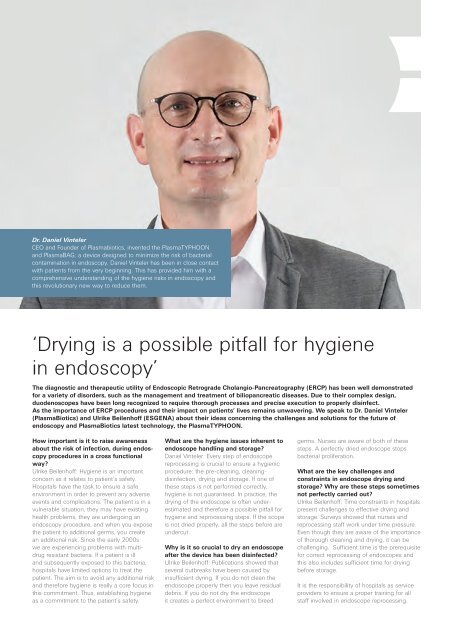You also want an ePaper? Increase the reach of your titles
YUMPU automatically turns print PDFs into web optimized ePapers that Google loves.
Dr. Daniel Vinteler<br />
CEO and Founder of Plasmabiotics, invented the PlasmaTYPHOON<br />
and PlasmaBAG; a device designed to minimize the risk of bacterial<br />
contamination in endoscopy. Daniel Vinteler has been in close contact<br />
with patients from the very beginning. This has provided him with a<br />
comprehensive understanding of the hygiene risks in endoscopy and<br />
this revolutionary new way to reduce them.<br />
‘Drying is a possible pitfall for hygiene<br />
in endoscopy’<br />
The diagnostic and therapeutic utility of Endoscopic Retrograde Cholangio-Pancreatography (ERCP) has been well demonstrated<br />
for a variety of disorders, such as the management and treatment of biliopancreatic diseases. Due to their complex design,<br />
duodenoscopes have been long recognized to require thorough processes and precise execution to properly disinfect.<br />
As the importance of ERCP procedures and their impact on patients’ lives remains unwavering. We speak to Dr. Daniel Vinteler<br />
(PlasmaBiotics) and Ulrike Beilenhoff (ESGENA) about their ideas concerning the challenges and solutions for the future of<br />
endoscopy and PlasmaBiotics latest technology, the PlasmaTYPHOON.<br />
How important is it to raise awareness<br />
about the risk of infection, during endoscopy<br />
procedures in a cross functional<br />
way?<br />
Ulrike Beilenhoff: Hygiene is an important<br />
concern as it relates to patient’s safety.<br />
Hospitals have the task to ensure a safe<br />
environment in order to prevent any adverse<br />
events and complications. The patient is in a<br />
vulnerable situation, they may have existing<br />
health problems, they are undergoing an<br />
endoscopy procedure, and when you expose<br />
the patient to additional germs, you create<br />
an additional risk. Since the early 2000s<br />
we are experiencing problems with multidrug<br />
resistant bacteria. If a patient is ill<br />
and subsequently exposed to this bacteria,<br />
hospitals have limited options to treat the<br />
patient. The aim is to avoid any additional risk<br />
and therefore hygiene is really a core focus in<br />
this commitment. Thus, establishing hygiene<br />
as a commitment to the patient’s safety.<br />
What are the hygiene issues inherent to<br />
endoscope handling and storage?<br />
Daniel Vinteler: Every step of endoscope<br />
reprocessing is crucial to ensure a hygienic<br />
procedure: the pre-cleaning, cleaningdisinfection,<br />
drying and storage. If one of<br />
these steps is not performed correctly,<br />
hygiene is not guaranteed. In practice, the<br />
drying of the endoscope is often underestimated<br />
and therefore a possible pitfall for<br />
hygiene and reprocessing steps. If the scope<br />
is not dried properly, all the steps before are<br />
undercut.<br />
Why is it so crucial to dry an endoscope<br />
after the device has been disinfected?<br />
Ulrike Beilenhoff: Publications showed that<br />
several outbreaks have been caused by<br />
insuffi cient dyring. If you do not clean the<br />
endoscope properly then you leave residual<br />
debris. If you do not dry the endoscope<br />
it creates a perfect environment to breed<br />
germs. Nurses are aware of both of these<br />
steps. A perfectly dried endoscope stops<br />
bacterial proliferation.<br />
What are the key challenges and<br />
constraints in endoscope drying and<br />
storage? Why are these steps sometimes<br />
not perfectly carried out?<br />
Ulrike Beilenhoff: Time constraints in hospitals<br />
present challenges to effective drying and<br />
storage. Surveys showed that nurses and<br />
reprocessing staff work under time pressure.<br />
Even though they are aware of the importance<br />
of thorough cleaning and drying, it can be<br />
challenging. Suffi cient time is the prerequisite<br />
for correct reprocessing of endoscopes and<br />
this also includes suffi cient time for drying<br />
before storage.<br />
It is the responsibility of hospitals as service<br />
providers to ensure a proper training for all<br />
staff involved in endoscope reprocessing.

















